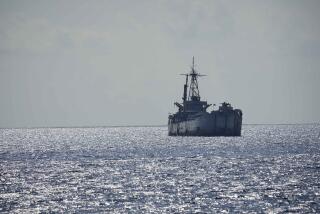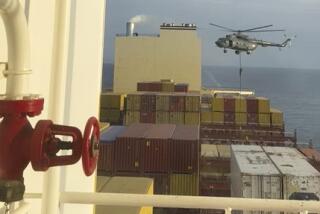Hijacked U.S.-flagged ship arrives in Kenya
- Share via
MOMBASA, KENYA — The first slivers of information about crew members’ dramatic battle to regain control of their U.S.-flagged ship from Somali pirates emerged Saturday night as the Maersk Alabama finally docked in this Kenyan port.
From the ship’s deck, exhausted crewmen shouted about heroism, and one pumped his fist in the air in jubilation as they approached the dock in the darkness.
But the men’s relief was tempered by the knowledge that their captain, Richard Phillips, was hundreds of miles away off the coast of Somalia, drifting with desperate pirates in a lifeboat that had run out of fuel. Saturday was his fourth day in captivity. A day earlier, Phillips had tried to escape by jumping overboard, but was immediately recaptured by the pirates.
Details are sketchy, but Phillips had reportedly surrendered himself to the pirates to secure the safety of the 19 crew members.
With a heavy security cordon in place at the Mombasa port, and a screen of shipping containers erected to protect crew members’ privacy, access was limited. But a couple of crew members spoke to reporters, and told of other heroic acts.
“Hey, this guy’s a hero!” one said, indicating the ship’s chief engineer, A.T.M. Reza. He described how Reza managed to lure one of the pirates into a trap in the engine room. Details of the saga were obscured as reporters shouted questions, and it was not known whether the pirate whom Reza nabbed later managed to flee with the captain.
In another attack Saturday off the coast of Somalia, a lawless country that has had no stable government since 1991, pirates hijacked a tugboat and were holding its mostly Italian 16-member crew as hostages, maritime officials in Kenya said. The tugboat is Italian-flagged, but its ownership was unclear.
The latest hijacking brought the current total of pirated ships to more than 20, with about 300 hostages.
As the U.S. drama continued, family members of the four pirates who are holding Phillips and elders from their hometowns gathered Saturday at the Somali coast in an attempt to help end the standoff between the captors and the U.S. destroyer Bainbridge, which is monitoring the situation nearby.
“They wanted to free the captain without ransom and arrange to take the pirates back home safely,” said Abdi Gaariye Samatar, who is part of a pirate gang in the Somali port city of Eyl.
“The elders are worried about the American warships surrounding the pirates,” he said.
A maritime expert in Kenya, who spoke on condition of anonymity, said the family members and elders spoke with U.S. negotiators and sought a written assurance that the Americans would permit them to bring the pirates back to Somalia for prosecution rather than have them be detained by the United States.
“The Americans refused,” the expert said. “They said they would not guarantee that the elders could take the boys.”
John Reinhart, president and chief executive of Maersk Line, said the Maersk Alabama’s crew would not be allowed to leave the ship and be reunited with their families until an FBI investigation is complete.
“Because of the pirate attack, the FBI has informed us that this ship is a crime scene,” he said Saturday afternoon during a short news briefing from the company’s headquarters in Norfolk, Va.
Crew members will be given telephones to call their families, but Reinhart said it was unclear how long the FBI questioning would take.
He said he spoke with some of the crew members and they expressed concern about the captain.
“One of the things they asked was to make sure we do everything we can to bring home the captain,” he said.
Despite intense interest in hearing details of how the crew retook control of the vessel, and whether Phillips volunteered to board the lifeboat with the pirates in return for his men’s safety, Reinhart said he could not provide any specifics of the investigation to date or the status of the negotiations because such information “could pose a risk to our primary purpose,” which was Phillips’ safe return.
“I’m not going to say that he gave himself, because that is speculating,” Reinhart said.
The relief was palpable among some crew members when the ship slowly approached the dock at Mombasa’s port and a mooring rope was thrown.
“Are you guys all from the States?” one crew member said to the crowd of waiting journalists. “Really?”
“When I get home I’m going to hug my wife and kids, my boys.”
And the first meal?
“Steak!”
But with the captain’s life still in danger, not all the crew members were pleased to see the crowd of reporters. One crewman approached and stared for some minutes with obvious anger and contempt, before cursing and calling the journalists “leeches.”
Many of the crewmen, wearing blue coveralls and blue hard hats, appeared exhausted. A bus was brought to the dock, ready to take the crew members away after the debriefing.
Analysts and diplomats see resolving Somalia’s long-running civil strife as the key to the country’s piracy problem.
“It’s a bit difficult to patrol the sea, it’s so vast. It’s a land-based problem. If we can get the political situation in Somalia squared away, they won’t have a base to operate from,” the diplomat said.
Pirates often use large “mother ships” disguised as fishing boats as their ocean bases. Then they attack in powerful speedboats.
By the time the crew members realize that an attack is underway, the pirates are just minutes from the final move -- boarding the ship using grappling hooks, or even ladders, and firing machine guns and grenade launchers.
They typically gain control within a few minutes, and take the vessels to their bases in Somalia.
--
Times staff writers Edmund Sanders in Djibouti and Josh Meyer in Washington and special correspondents in Mogadishu, Somalia, contributed to this report.
More to Read
Sign up for Essential California
The most important California stories and recommendations in your inbox every morning.
You may occasionally receive promotional content from the Los Angeles Times.










